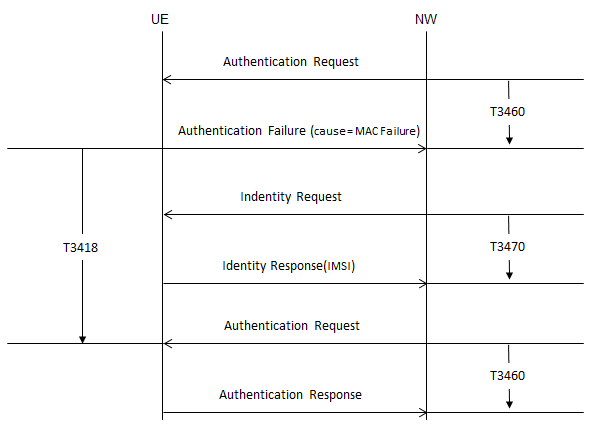|
T3460
Purpose of T3460: Timer T3460 is used in the NAS procedures to ensure proper communication between the network (MME) and the UE during critical signaling exchanges, such as Authentication and Security Mode Control. It sets a time limit for the UE to respond to network-initiated messages like AUTHENTICATION REQUEST or SECURITY MODE COMMAND. If the timer expires without a response, the network takes specific recovery actions.
T3460 is critical for:
- Ensuring timely responses from the UE.
- Recovering from transient communication failures through retransmissions.
- Providing a controlled mechanism to terminate stalled procedures, maintaining the efficiency and reliability of the network.
Key Scenarios Involving T3460
Authentication Procedure:
-
Initiation: When the network sends an AUTHENTICATION REQUEST, it starts timer T3460. The timer runs until the network receives a response (AUTHENTICATION RESPONSE or AUTHENTICATION FAILURE).
-
Completion: Upon receiving the response, the network stops T3460 and processes the received data (e.g., verifying the response).
-
Expiry: If T3460 expires before receiving a response:
-
The network retransmits the AUTHENTICATION REQUEST and restarts T3460.
-
This process is repeated four times. If T3460 expires a fifth time, the network:
-
Aborts the authentication procedure.
-
Ends any ongoing EMM-specific procedures.
-
Releases the NAS signaling connection.

Security Mode Control Procedure:
- Initiation: The network starts T3460 after sending a SECURITY MODE COMMAND to the UE.
- Completion: T3460 is stopped when the network receives a SECURITY MODE COMPLETE message. After this, all signaling is protected using the selected integrity and encryption algorithms.
- Abnormal Cases:
- If T3460 expires, the network retransmits the SECURITY MODE COMMAND and restarts the timer. This is repeated up to four times. After the fifth expiry:
- The network aborts the security mode control procedure.
- Any related EMM-specific procedures are stopped.
Handling Abnormal Scenarios
- Lower Layer Failures: If a failure occurs at lower layers before receiving the expected response (e.g., AUTHENTICATION RESPONSE or SECURITY MODE COMPLETE), the network stops T3460 and aborts the procedure.
- Retries and Abortion: The network ensures multiple retries to accommodate temporary issues, but after five failures (T3460 expiries), the procedure is deemed unsuccessful, and the connection or process is terminated.
- EPS Security Context: If a security mode or authentication procedure is aborted, both the UE and network revert to the last known EPS security context (if available) to maintain communication integrity.
|
|
